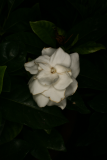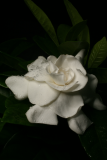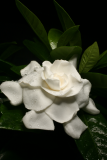Additional notes (click to expand)
Commemorative
This, the Cape Jasmine, was named for Dr Alexander Garden FRS (1730–91), Scottish-born physician and naturalist who lived in Charles Town (now Charleston), South Carolina, and corresponded with Linnaeus and many of the botanists of his era. Widely honoured in his day as a botanist and ‘the most famous physician of colonial times’ (McCrady, 1897), he might have disappeared forever into the mists of history, save for the plants named after him. His father was the minister of the church in Birse, in north-east Scotland, and here Garden acquired his love of nature and books. He entered Marischal College (University of Aberdeen) in 1743 (aged 13) as apprentice to Dr James Gordon, the professor of medicine. In 1746 he went to London, and after an interview with the navy, passed the exam at Surgeon’s Hall, qualifying as a surgeon’s second mate. He failed to get a posting so returned to Aberdeen to continue working with Professor Gordon until 1748. He then retook the examination, this time passing as eligible to be a surgeon’s fi rst mate on any ship. He first worked on a small vessel, HMS Tryton, and then in 1749 on HMS Eagle, but transferred to a small sloop called the Porcupine, which he disliked. He returned to his studies in Edinburgh, qualifying in 1751. He did not have the money to pay for his degree certificate, which he needed to practise in Scotland, and was suffering from tuberculosis, so decided to emigrate to a warmer climate. On the invitation of Dr William Rose he sailed to South Carolina in 1752 and set up
practice with him. Within 10 days of arrival he had become fascinated by the new plants he encountered, sending a parcel of ‘pink root’ (Spigelia merilandica, a once-popular, highly-toxic remedy for intestinal worms) back to Dr Rutherford in Edinburgh. He became interested in plant poisons with which the slaves were allegedly poisoning their owners – he did not believe this – and noted their knowledge of these matters. His illness confined him to bed for nine weeks, but he started a correspondence with the Rev Stephen Hales (qv under Halesia) in England which continued until his death. He collected seeds, sending them back to England, received his degree from Marischal College in 1755 and, having seen a copy of Linnaeus’s Critica botanica in 1755, commenced to correspond with him (Linnaeus did not reply until 1759) and many other botanists in Europe. In 1755, he accompanied the governor of Charles Town into Cherokee country, which he found botanically very interesting.
Oakeley, Dr. Henry. (2012). Doctors in the Medicinal Garden. Plants named after physicians. Royal College of Physicians. page 65
link
He married Elizabeth Peronneau on Christmas day 1759. They were to have three surviving children, coming through the smallpox epidemic of 1761 – Garden inoculated many of the residents. During the next decades he sent plants and animals, some new to science, back to the English botanist John Ellis in London and to Linnaeus in Sweden. He sent back the first electric eel, discovered the Congo snake, Amphiuma means,and the mud eel, Siren lacertina. Ellis named the Cape Jasmine, Gardenia jasminoide, – which arrived in England from Asia in 1750, but was believed to have been a South African plant – after him in 1761. Many of the indigenous plants that he sent back to Europe were grown in his elaborate garden in Otranto, outside Charleston (Cothran, 1995). He was elected FRS in 1773. Such was the wealth of his correspondence that his name is the most frequently quoted in the last edition of Linnaeus’ Systema naturae (1793). Linnaeus, aware of his long correspondence with Dr John Fothergill (who had sponsored the botanical travels of the American botanist John Bartram in Carolina) joined their names in naming Fothergilla gardenii (qv). He supported the British side during the American War of Independence and was consequently exiled and had to return to London (1783), losing all his fortune and property as a result. His hopes of continuing his study of Californian botany in retirement were abruptly ended. However, his son (also Alexander) fought on the side of the revolutionary army in 1780 and his father’s estates were restored to him. He became active within the Royal Society in London, becoming its vice-president. However, his health remained poor and he died of tuberculosis in 1791 (Berkeley, 1969).
Oakeley, Dr. Henry. (2012). Doctors in the Medicinal Garden. Plants named after physicians. Royal College of Physicians. page 65
link
Other use
Gardenia jasminoides J.Ellis Rubiaceae. Cape jasmine - as erroneously believed to have come from South Africa. Distribution: China. Named for Dr Alexander Garden FRS (1730-1791) Scottish-born physician and naturalist who lived in Charles Town, South Carolina, and corresponded with Linnaeus and many of the botanists of his era. The fruits are used in China both as a source of a yellow dye, and for various unsubstantiated medicinal uses. Other species of Gardenia are found in tropical Africa and the roots and leaves have all manner of putative uses. Gardenia tenuifolia is used as an aphrodisiac, for rickets, diarrhoea, leprosy, gall bladder problems, toothache, liver complaints, diabetes, hypertension, malaria and abdominal complaints. It causes violent vomiting and diarrhoea. It, and other species, are used to poison arrows and to poison fish. Some native, muthi medicine, healers regard Gardenia as a ‘last chance’ medicine, given to patients when all else fails – the patient either dies or recovers (Neuwinger, 1996).
Oakeley, Dr. Henry F. (2013). Wellcome Library notes.
link
Gardenia jasminoides J.Ellis
Family: RUBIACEAEGenus: Gardenia
Species: jasminoides J.Ellis
Distribution summary: Asia
Habit: Shrub
Garden status: Not currently grown
Reason for growing: Commemorative




